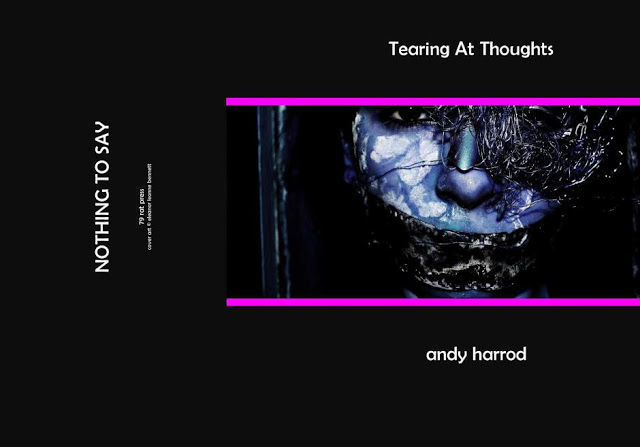Tearing at thoughts by Andy Harrod
-Reviewed by Rosie Breese–
As Andy Harrod’s website bio explains, he writes “not out of a desire to tell stories, but a need to understand, to develop meaning and connect with myself, others and life”. Fittingly then, his latest collection, Tearing at Thoughts from 79 Rat Press, is an unapologetically candid exploration of the workings of a mind – or series of minds – turning over experiences that are rarely talked about in public.
There’s no contents page, no numbering even. This is a book to get lost in, literally. Poems and photographs are collaged with story-fragments and snippets of text juxtaposed at different angles, making use of font and sizing to emphasise and defamiliarise. Perhaps this is why, when first flicking through Tearing at Thoughts, I was reminded of Marie Calloway’s divisive What purpose did I serve in your life. There’s a real openness about the way these collections are put together – a careful DIY layering of a variety of media in order to build a human picture that is as honest as it is unflinching. Both make the reader question their own voyeurism, their desire to keep reading.
However, where Calloway’s writing moves with cool precision between the external and external world, Harrod is concerned with memories, with the internal monologue, the stream of consciousness, as seen here in ‘Strangled by Fear’, a narrative fragment juxtaposing the contents of a letter with the speaker’s memories of a relationship and their own internal mutterings:
‘I had snapped. I had fizzed; I had pushed. I had smeared thick black lines across us. She stood on the doorstep, the tears dripped from her cheeks, in between the droplets she said she still loved me. I closed the door. She is wrong to believe still. I am too poisoned to be healed.’
The bulk of this collection plays with the form of the half-told story, the details given out selectively, the focus on the internal drama that is so difficult to articulate. The experiences of the speakers are overwhelmingly traumatic: a father is separated from his children; a victim of sexual abuse hides out in a wood; a counsellor listens to a client describing the horrific violence of their childhood. These longer episodes are interposed with shorter pieces that are bold in their attempts to articulate the incommunicable, as seen here in the aptly-titled ‘truth’:

A particularly poignant moment is the appearance of three postcards – literally postcards, scanned in – that function as messages from a tortured internal world. The addresses are blacked out, casting doubt on the possibility of a reader, a sympathetic ear, a home for these thoughts:
Although Harrod’s experiments with form and medium are refreshing in their variety, the weight of the subject matter and the sheer volume of permutations of human suffering does get a bit much. On top of this, abstract, sometimes vague language is used to grapple with the inexpressible, resulting in phrases like ‘failure assumed’, in the example above, and ‘conflicted and lonely pain shot through my mind’, in opening piece ‘Care to dance?’ In particular, the word ‘black’ crops up so often that it barely seems to mean anything; it becomes a sort of shorthand for pain, to the point where you begin to wonder whether there are other words that could have cut to the chase more effectively.
However, this is a volume that deals with the difficult, the inexpressible. And the reality of these difficult experiences is that they are hard to talk about. Anxiety is nebulous and difficult to pin down; depression is a gradual deadening of the senses and emotions. Our thoughts get out of control; words quite literally fail us. So perhaps it’s as well that Harrod’s treatment of these subjects reflects their difficulty, their numbing effects.
Interestingly, Harrod’s blog is titled ‘decoding static’, and this is just what this collection attempts to do – to forge a path through the noise of a disturbed mind, exploring every diversion and dead end. Googling Harrod threw up a review that described this collection as a ‘perfect summer read’. I’m not sure I’d take it with me for a relaxing day at the beach, but it’s certainly a bold collection, and a passionate one.
Tearing at Thoughts is available to download for free from 79 Rat Press along with 5 other collections by Paul Askew, Sian S. Rathore, Kiran Millwood Hargrave, Emily Harrison and Jared Joseph.






Thank you Rosie for your honest review, which, for me, shows your engagement with tearing at thoughts. As a writer I cannot ask for more from a reader, to engage and interact with my stories.
I hadn’t notice how often I use black to mean pain/upset/sadness/lost, as the stories were written over a number of years and brought together for this collection. It is useful to have that picked up on, as I agree on some occasions another word may be more suitable and meaningful to that situation. But as you note sometimes there are no words, only a sensation and on those occasions ‘black’, for me, fits.
I am aware how difficult a read tearing at thoughts can be and took the risk to leave the love and hope that drives the sharing of the stories in between the lines. I wanted the stories to stand on their own and am interested in the affect they have and didn’t want to bias them with my own hopes. As such I appreciate you taking the time to engage and be with the weight of tearing at thoughts.
Best wishes, Andy
Pingback: ‘Mammal’ by Jared Joseph | Sabotage